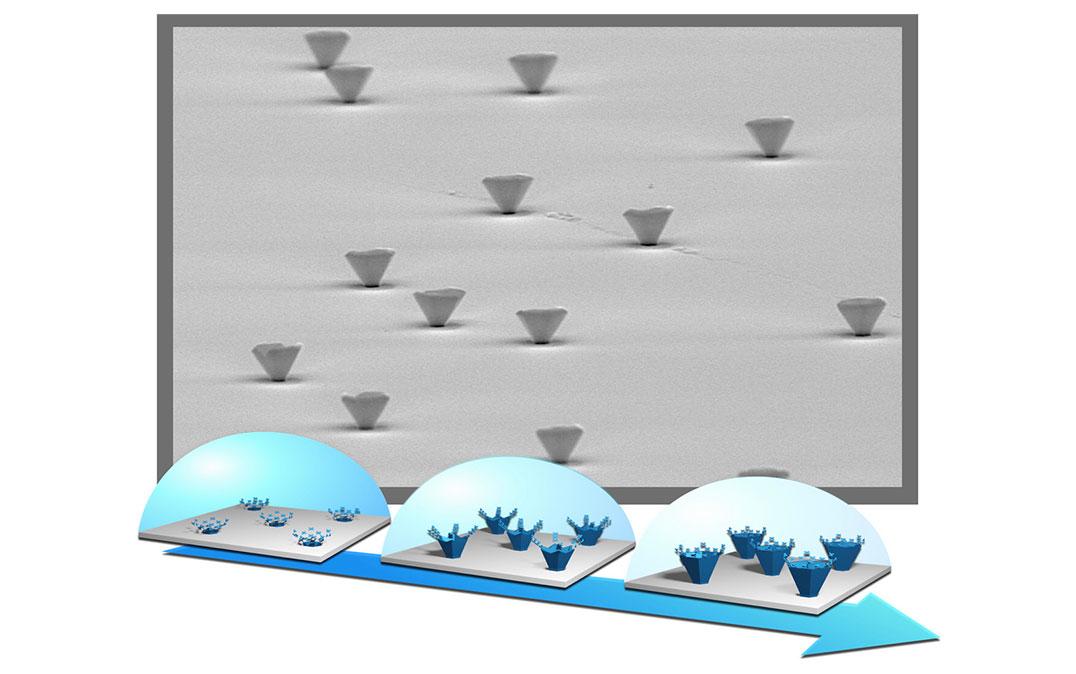Research News
Tiny Crystal Vases

Researchers at the University of Tsukuba report a new procedure to produce microscopic single crystals in the shape of hollow vases based on spontaneous crystal growth, which may provide a source of storage containers for nanotechnology applications.
Tsukuba, Japan—Scientists from the Department of Materials Science at the University of Tsukuba developed a new method to produce micrometer-scale single crystals in the form of hollow vessels. By drop-casting an ethanol solution onto a quartz substrate, the molecules can spontaneously assemble into the proper shape. This research may open the way for a new line of experiments in which chemical processes can be contained within these microscopic vessels.
Placing a fancy bowl made of crystal in a conspicuous spot in your house can make a positive impression on your guests. But an even more impressive feat would be the ability to create such a vessel as a single microscopic crystal. While some tiny organisms have been known to exhibit this type of expertise, it can be challenging to scientists to reproducibly make these nano-containers, because uncontrolled growth can lead to misshapen final products.
Now, a team of researchers at the University of Tsukuba have reported a new procedure to reproducibly create hollow vessel-shaped crystals that are uniform in size and attached to a substrate with their open side facing upwards. The crystals were grown from molecules that had a paracyclophane core and with four (methoxyphenyl)ethynyl arms, called (S)-CP4, or its mirror-image molecule, (R)-CPP4. To produce the vases, a heated solution of (S)-CPP4 was gently dropped onto a quartz substrate under ambient conditions. When the solution cooled, the molecules began to spontaneously crystallize. "Using this procedure, we were able to achieve synchronous, uniaxial, and stepwise growth of micrometer-sized single crystals," says senior author Professor Yohei Yamamoto.
The team used X-ray crystallography and scanning electron microscopy to study the resulting structures. The side walls of the vessels grew outward with hexagonal symmetry, leaving a void inside the facets. The size of the side walls was found to be nearly constant, with a thickness of just 500 nanometers. The researchers also showed how strong intermolecular interactions give the vessel mechanical strength. Many crystal vessels can be fabricated simultaneously, and a variety of shapes can be produced. For example, excess edge or body growth gives rise to "flower" or "jewel" forms, respectively.
"Hollow crystals with Intricate morphologies and well-developed crystalline edges and facets can be very useful as tiny containers," says Professor Yamamoto. As a proof-of-concept, the team melted a tiny sample inside a crystal vessel and found that the resulting liquid stayed inside. On the basis of this, we might see a new type of micro-sized lab equipment, in which reactions can be performed with extremely small amounts of chemicals.
###
This work was supported by CREST (JPMJCR20T4) and ACT-X (JPMJAX201J) from
Japan Science and Technology Agency (JST), Grant-in-Aid for Scientific Research on Innovative Areas "π-System Figuration" (JP17H05142, JP17H05165), Scientific Research (A) (JP16H02081), Scientific Research (B) (JP19H02792), Challenging Research (Exploratory) (JP21K18860), and Young Scientist (JP19J20398) from Japan Society for the Promotion of Science (JSPS), and Ogasawara foundation.
Original Paper
The work is published in Science as "Synchronous assembly of chiral skeletal single-crystalline microvessels" (DOI: 10.1126/science.abm9596).
Correspondence
Professor YAMAMOTO Yohei
Faculty of Pure and Applied Sciences, University of Tsukuba
Related Link
Faculty of Pure and Applied Sciences




